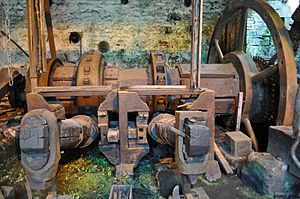Abbeydale Industrial Hamlet facts for kids
Abbeydale Industrial Hamlet is a cool industrial museum located in the south of Sheffield, England. It's built on an old steel-making site right by the River Sheaf. People have been working with metal here since at least the 1200s!
The museum shows what the Abbeydale Works used to be like. This was a place where scythes (a type of tool for cutting grass) were made until the 1930s. It's a really complete example of a 19th-century factory. What's special is that most of the work, from start to finish, happened all in one place, a bit like a modern factory. Another old water-powered site nearby is Shepherd Wheel.
Abbeydale Industrial Hamlet is so important that it's a "scheduled monument." This means it's a nationally important historical site. Many of its buildings are also "listed," which protects them because they are special.
History of the Hamlet
For about 500 years, this site was used for iron forging, which is shaping metal with heat and hammers. There's even proof that other metal work happened here before the year 1200. The early history of the site is closely connected to Beauchief Abbey, a nearby religious house. The Abbey had a blacksmith's shop and several mills along the River Sheaf.
In 1725, a map showed that the fields, which later became the dam for the site, were called "Sinder Hills." "Cinders" were the waste left over from lead smelting (melting metal from its ore) that happened in the area in the 1500s and early 1600s. The "Abbey Dale Works" as we know it, with its current buildings, was first officially recorded in 1714.
The site grew over many years:
- In 1777, the dam was made bigger.
- A large "tilt hammer" was built in 1785.
- Homes for the workers were built in 1793.
- A "grinding hull" (a building for grinding tools) was added in 1817.
- The manager's house was built in 1838.
- A coach house and stables were built in 1840.
- In 1876, a warehouse was added above the blacking shop.
From the 1600s onwards, the site mainly made scythes. It finally closed in 1933. In 1935, a man named Alderman J. G. Graves bought the site and gave it to the city. The works even opened briefly during the Second World War to help with Britain's war effort.
In 1964, a group called the Council for the Conservation of Sheffield Antiquities started to restore Abbeydale Works. They found the remains of six more buildings that were no longer standing. These included old workshops, sheds, and a boiler house. After a lot of restoration work, the site finally opened as a museum in 1970.
Sheffield City Council closed the museum in 1997 to save money. But then, the Sheffield Industrial Museums Trust took over, and they reopened the museum in 1998.
What You Can See at the Museum
Abbeydale Industrial Hamlet is a "working museum." This means you can see how things were made using machines and buildings from the 1700s and 1800s. The museum shows how "blister steel" was made from iron and coke. Then, they show how this steel was made even better using a special method called "crucible steel," invented by Benjamin Huntsman.
The River Sheaf provides water power to turn the water wheels. These wheels power different machines:
- A "tilt hammer" for shaping the scythe blades.
- Grinding machines for sharpening. These also had a steam engine as a backup if the river water was low.
- A set of bellows to blow air into furnaces.
The blades were also shaped by hand to finish them perfectly.
The museum is open from Thursday to Sunday during its busiest season. The best part is that entry is free! It's a great place to learn about how things were made long ago.
See also




